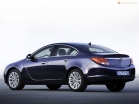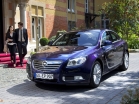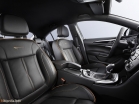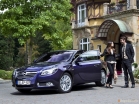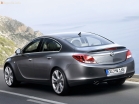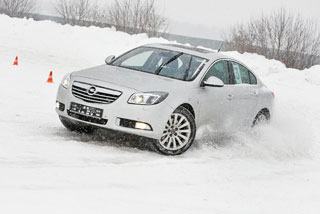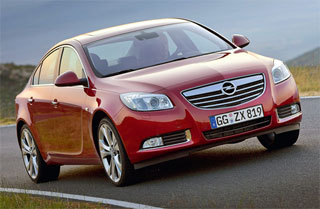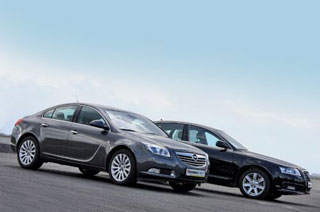Test drive Opel Insignia sedan since 2008 sedan
Indian summer
Opel Insignia received a Russian passport and new configurationsRusslandDeutsche with such a cunning word in the German manner in Opel is now called the flagship of Insignia: Russian German. Is the hint? Opel Insignia received a Russian residence permit and became the fifth model with lightning on the emblem, which gathers in the vastness of our vast Motherland.
The launch of Russian production of insignia coincided with the withdrawal of new sets and modifications of this model to the market, which will make it even more attractive to buyers. In order to find out more details about the newly-minted Russian German, we went to the vicinity of St. Petersburg. Of course, closer to the factory in Shushara, where the GM plant is located, you decided. And they did not guess Opel Insignia not here, but on the Kaliningrad Automobile Training. And the Leningrad Region was chosen as a platform for the presentation only because there are enough monuments of history and architecture, which are somehow related to the activities of RUSSLANDDEUTSCHE.

The launch of the local production of the Opel flagship will not only reduce the prices for the model, but also help Russian dealers not depend on the supply of cars from Rysselheim and reduce the waiting time for the ordered cars. The fact is that in Europe, Insignia is sold very well, so the German plant, first of all, supplies cars to domestic and neighboring markets, and then, by residual principle, distributes cars to other countries.
The Kaliningrad site was chosen for several reasons. Firstly, the Ji-Um factory near Peter is now loaded so much that the leadership has decided to launch the third shift at the enterprise. But a more good argument is that from the point of view of logistics, Kaliningrad is better suited for assembling cars in small batches here flexible production, the plant is located closer to Germany, and it is easier and faster to carry machine tools.
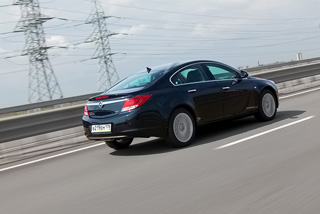
In Kaliningrad, all modifications of the sedan, hatchback and station wagon are collected, including cars with diesel engines, except for the charged version of the OPC. Thanks to the local assembly, the car became cheaper: its initial price decreased to 777 thousand rubles, and the upper bar dropped to 1 million 609 thousand 500 rubles. Russian insignia has already entered sale.
In addition, in Kaliningrad, they already brought a hand on other Opel models here, the previous generation Opel Astra, as well as the Zafira and Meriva models, are being assembled here. The production of new insignia is carried out by a large -sized SKD method, one machine tool consists of about fifty components. Production volumes before the end of this year are still unknown, it all depends on the number of cars ordered (about 1800 cars were sold in the first half of the year), but next year Opel plans to sell up to five thousand Opel Insignia in Russia, and, according to the leadership, 70 percent of orders believe We'll have to go to sedans.
New package configurations of cars also appeared. The main innovation of the 2011 model year is the appearance of the Business Edition version with a two-liter 160-horsepower CDTI turbodiesel engine and an automatic gearbox. Partly, this version resembles Cosmo, but Business Edition flaunts a richer equipment. In addition, the 160-horsepower unit is a golden middle between a 140-horsepower 1.8-liter gasoline engine and a two-liter 220-horsepower turbo engine. So far, the car in this version is offered only with the sedan body for 1,190,700 rubles.

The Business Edition package for Insignia is something like a special series for Mercedes-Benz special equipment in which the equipment is selected taking into account customer requests. The car has almost everything that the majority of buyers from a car of this class awaits: light and rain sensors, fog lights, external mirrors with electric drive, heating and photocells, tire pressure sensor, electromechanical parking brake, front and rear parking sensors, leather salon, electro -regulating Driving chair, two-zone climate control, bixenon adaptive headlights, radio navigation complex of the CD 500 Navi car radio with color display and seven speakers, Bluetooth, USB-and AUX outputs. For this version, no options are offered, the client can only choose the color of the body or purchase additional accessories.
We managed to ride both on the station wagon and on a sedan working on heavy fuel. The first thing you pay attention to is the presence in the salon of vibrations and noise at idle, which do not allow you to forget that this motor consumes diesel fuel. However, vibrations disappear in the movement.
In terms of dynamics, the diesel Insignia middle peasant. The car accelerates well, but without any claims for active ride. The six-speed machine has long transfers that, together with the engine, which picks up somewhere from 1700 revolutions and is spinning well thousands to four, allows you to make a minimum of switching during acceleration. In 10 seconds, the speed will exceed a hundred, and the reserve of traction is enough to also vigorously dial another 40-60 kilometers per hour. True, the transmission reacts to the Kik-Daun with a second delay, but honestly holds the transmission in manual mode, even if the tachometer arrow rested on the limiter.

From August 1, a hatchback will be added to the sedan in the Business Edition version, which, in addition to all of the above, will have a Quickheat electric heater, an improved multimedia system CD 600 Navi and wheels of other design. In this case, the price will increase by only five thousand rubles and amount to 1,195,700 rubles.
But the most pleasant thing is to set the sensitivity of the gas pedal on diesel insignia is easy to maintain constant speed on the highway what you need to drive long distances.
I especially liked the configuration diesel engine + automatic + body universal body this option is perfect for the role of family cars. We should not forget about the modest appetite, fuel consumption on a test car did not exceed nine liters of diesel fuel one hundred kilometers, although we made enough accelerations and braking in the city and moved by no means with a turtle on the highway along the highway. The only drawback of the station wagon is a slightly higher, compared to sedan, the level of noise, both aerodynamic and tires.
Interior:

Now, for rich Cosmo sets (from 977 thousand rubles) and Sport (from 1,130 thousand rubles), a limited version of Indian Summer is offered with exclusive interior decoration. Translated from the English Indian Summer means the phrase golden autumn or Babier summer.
Car interior is sewn from Connolly a special red color. By the way, a similar skin of exactly the same shade can be found, for example, in Jaguar XFR. In addition, a sewing of the leather steering wheel and lever of the box in color also coincides in color with seats and door panels.
The Indian Summer package increases the cost of the machine by 90-95 thousand rubles, depending on the availability of the ventilation system in the front seats.
There are other news for lovers to drive. The first is that from now on, the charged modification of the Insignia OPC can be ordered with a six -speed automatic transmission, which has the gearboxes on the steering wheel. It costs two-pedal inSignia OPCs for 47 thousand rubles more than a version with a six-speed manual gearbox of 1,656,500 rubles, and the most pleasant, the automatic implantation has not much worsened the acceleration dynamics, which according to the passport is from 6.3-6.6 seconds, depending on the type The body instead of 6-6.3 seconds on mechanics.
The adaptive control unit of automatic transmission is an integral part of the Flexride mechatron chassis, which controls the sharpness of the reaction to pressing the gas pedal, the threshold for the stabilization system, the sensitivity of the steering and the operation of the full -wheel drive system. If in the civil versions of insignia there are two TOUR pre -installations for everyday driving and Sport for dynamic driving, then OPC will already have three modes: Standart, Sport and OPC. In the latter case, the backlight changes the color to red, reporting that the machine is in full combat readiness.
The second news is addressed to those who are accustomed to violating the high-speed limits of the traffic rules: in Russia, an all-wheel drive model of the Opel Insignia OPC with a mechanical six-speed gearbox and the speed limit is now sold in Russia. In the sled characteristics of the Insignia OPC Unlimited, it is no different from the usual OPCs, except for a higher maximum speed of 270 kilometers per hour.

From the standard OPC, the Unlimited version is distinguished by the presence of a blue Brembo logo on brake calipers, as well as a different design of the tachometer and speedometer inside. All alterations pulled for 15 thousand rubles just so modification of Unlimited more than a conventional OPC. Soon cars with black matte color will appear.
On both cars, we managed to drive along the closed airfield, which is located near Pulkovo Airport. The first is a snow -white station wagon in the Unlimited version, the second bright blue sedan with an automatic gearbox. Even before the start of the races, we rubbed the pens and wondered what the organizers prepared so interesting, because we were still handing us racing gloves with OPC symbols
The predatory body kit, the juicy roar of the motor, low-profile rubber Pirelli P Zero on optional forged 20-inch discs, perforated brake discs, tight-fitting buckets of Recero, chubby leather bagel in the hands, and in front are a wide and straight runway!

Opel Insignia OPC Unlimited car, which is nice to rush through high -speed autobahns. But only in Russia there will nowhere to fully evaluate its capabilities.
But, alas, I didn’t even succeed in turning the buzz from driving on these cars, but just to at least try out the various modes of the mechatron chassis spent time for the wheel of both cars in total, it was barely exceeded 15 minutes, for which it was possible to accelerate before 150 kilometers per hour, followed by braking, drive a snake, perform a rearrangement, and a police reversal here is the whole program.
Yes, both machines are perfectly accelerated, the wheels are well obeyed, delighted with the absence of rolls and buildups, powerfully slow down from high speeds and allow you to quickly pass the same snake than their civil analogues. But this was understandable.

The INSIGNIA OPC inherited the Saabov models inherited the all -wheel drive system. It is based on a multi -disc sleigh of the fourth -generation Haldex with an electronic differential of increased friction ELSD (Electronic Limited Slip Differential) in the rear axle. The system knows how to transfer up to 100 percent of torque to one of the axes. In the usual state, the car remains front-wheel drive-the rear wheels are transferred up to 10 percent of the thrust, but at the command of electronics to the rear axle can be transferred up to 100 percent of the torque, and most of the thrust (up to 85 percent) can be transferred to one of the rear wheels.
Perhaps the automatic gearbox was really the most vivid impression. If you are not a racer-AC and do not have the skills of lightning-fast gear, then having given preference to the Insignia OPC on the machine, you will not regret your choice in real road conditions such a car by dynamics will not yield to a mechanical counterpart, or maybe it will be faster than it.
325-horsepower station wagon with all-wheel drive on the mechanics of a summer resident with Schumacher's ambitions
The Germans seem to have already taken root in Russia. First, Astra and Zafira appeared, then Antara and Meriva of the domestic assembly, and now Insignia has become another Russlanddeutsche. The registration in Kaliningrad made a car more accessible, and thought -out configurations will allow you to raise a customer interest in not the newest model. If in the past the main demand was for a 220-horsepower gasoline modification, now, most likely, the vector will shift towards the Business Edition version, which will significantly expand the consumer audience. And this means that Opel residents had a chance to firmly gain a foothold, if not in the top three, then exactly in the five leaders of the D-class.
Russian Germans russlanddeutsche, Russian Germans call the ethnic Germans, as well as German subjects, who lived and worked in Russia. The first references to the residence of the Germans in Russia date back to the 12th century, and during the reign of Ivan the Terrible in the cities the so -called German settlements began to appear in cities. The heyday of the German movement in Russia falls on the XVIII century, when foreign scientists, specialists, diplomats, artists, many of whom were from Germany were invited to our country.
Alternative
Ford Mondeo The most formidable competitor in the class of medium -sized sedans. This is one of the most affordable representatives of the segment D price for a model with a 1.6-liter 120-horsepower gasoline engine starts at 699 thousand rubles. Only the morally obsolete Taganrog Hyundai Sonata and the Korean Chevrolet Epica sedan is cheaper. Since last year, Mondeo offers a new line of engines, including a 240-horsepower two-liter gasoline engine Ecoboost and a 2.2-liter Duratorq TDCI turbodiesel with a capacity of 200 horsepower, which are set up with a six-speed pre-sequence robotic PowerShift transmission with two clutches.
This year Citroen C5 survived restyling. Outside, the updated car can be found out by the presence of LEDs in the front headlights and a slightly modified rear lighting equipment. The main innovations occurred under the hood. A 1.6-liter 150-horsepower turbo engine appeared in the model line, and the power of Biturbodiesel 2.2 HDI increased to 204 horsepower. The basic cost of a machine with a 120-horsepower 1.6-liter gasoline engine is 745 thousand rubles.
A new Volkswagen Passat appeared on the Russian market. If the car is seriously transformed outside, then inside the change is not so noticeable by eye. From the point of view of equipping the main innovation, it was that numerous single options have disappeared from the equipment list and from now on the car is offered in package trim levels. Passat B7 is available with three gasoline engines, with a capacity of 122 to 210 horsepower and one 170-horsepower turbodiesel. The price of a car begins from a mark of 859 thousand rubles.
Peter Bakanov
Photo by Peter Bakanov and Opel
Source: Motor magazine [July 2011]

